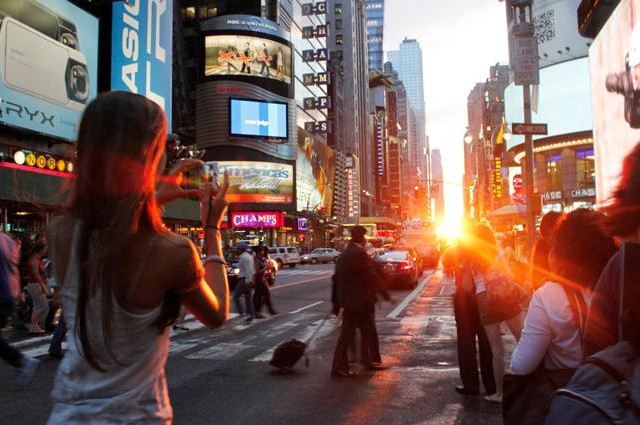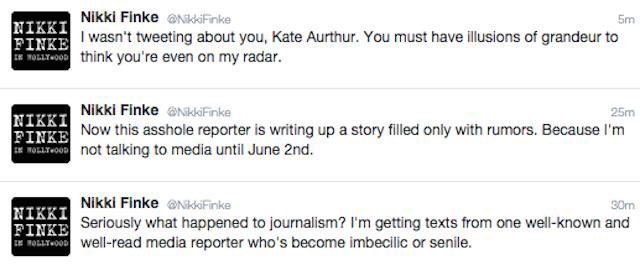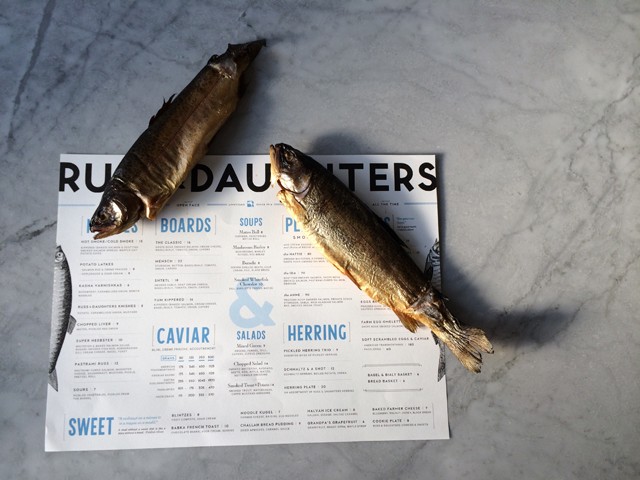Youth Humiliation Spectacle Completed
What better predictor of pain than certainty? If you expect something to go wrong, or know, by constant reminder, that it always might, then you are too buoyant to ever reach the emotional seafloor. To obsess about this is depression; to merely feel it is adulthood. This is why the people sacrificed in the Scripps National Spelling Bee every year must be children: Because adult failure, mitigated by experience and lived disappointment, is no fun at all. Congratulations to Sriram Hathwar and Ansun Sujoe.
The Data Thinks You're Weird
“It sounds like the ‘Am I normal?’ part of your question relates more to ‘eight times per week’ than ‘I masturbate,’ so let’s look at frequency: How often is too often?”
A Brief History of Manhattanhenge

Late this evening — be ready by 8 — the sun will fall into alignment with the Manhattan grid, illuminating the borough’s cross streets with a full, golden glow. In return, the city’s buildings will frame the sun perfectly: Photographers, charge your batteries!
You never know what else will happen during Manhattanhenge. In 1991, a dozen children rose from their strollers in the Upper West Side and walked into the park; they were found an hour later, pinned gently against the inside of the bandshell dome, laughing. During 1995’s second Manhattanhenge, a cub reporter at the Post, acting on an anonymous phone tip, stared directly into the sun and repeated an unfamiliar name six times. One week later, he tripped and fell onto the subway tracks; a woman grabbed him and rolled under the platform. The name was hers.
In 1999, Manhattanhenge didn’t really take because, as one attendee remembers, “it was foggy. No — really cloudy at a low altitude.” This, as with most historical Manhattanhenge occurrences, happened before the event had a catchy name or a large spectatorship. Most of the small gaggle of photographers, disappointed, didn’t bother to develop their film immediately; it wasn’t until months later, on Usenet, that two who did were able to compare shots. No city. A concrete room, no windows but brightly lit. A single folding table with two phones and an old yearbook.
In 2005, taxi drivers without a fare at peak Manhattanhenge, 8:13, later discovered that they had simultaneously taken payments ranging from a few dollars to over $70 from the same credit card number. Their records indicated that the totals were correlated with their distances, at the time, from Green-Wood Cemetery in Brooklyn.
We don’t talk about the year between 2008 and 2010, between 34th and 42nd, but we will never forget the sound.
In 2012, the birds became rats and the rats become birds. The lucky pigeons raced for the light at the end of the tunnel. The rest raced for the light at the front of the train.
Manhattanhenge in 2013 offered full and unconditional salvation to all who asked for it. Nobody knew, so nobody did.
Anyway, Gothamist has a good guide for tonight’s sunset, which will be most beautiful at 8:16, and recommends 14th, 23rd, 34th, 42nd, and 57th streets as observation points. Happy Instagramming!
Photo via Katie Killary
Spicy Condiment Still Produced in California
Sriracha, the overly well-regarded sort of hot sauce, will continue to be produced in Irwindale, California, keeping some eighty full-time jobs and two hundred seasonal jobs in the state, preventing their export to the worst of all possible places, Texas.
Who Else Missed Nikki Finke?
Who Else Missed Nikki Finke?

Nikkie Finke is back, or nearly back, which is a cause for celebration. Yes! It was easy to get distracted by the politics of the weird Deadline situation, or the specifics of her big blowout fights with Jay Penske and Sharon Waxman, and to forget that Nikki Finke is a consciously destabilizing force in every environment where she operates, and that that’s the point: She’s a filterless killer of a type that barely seems to exist on the internet, especially now. Kate Arthur writes that Hollywood, and the media, has largely moved on.
Maybe for Finke [her absence has] been difficult — but it’s been a joyful time for the publicists and executives who used to deal with her constantly.
“It’s a hundred times better in every way, shape, or form,” said one of the dozen people I spoke to for this story, all of whom insisted on anonymity because Finke is scary. “Everyone was trying to copy or trail her, so now everyone doesn’t feel like they have to be so ridiculous. I mean, the New York Times was chasing her. Things are almost normal.”
Have you ever read a better reason to be happy that someone is back? An un-ridiculous Hollywood press, one that doesn’t have at least one person trying to burn it all down all the time at all costs, sounds so terrible.
New York City, May 28, 2014

★★ Chilly and ominous. The first mosquito of the season, crouched on the wall behind the open headboard, died in a smear of someone’s bright red blood. The six-year-old had woken up a nosebleed despite the humidity; now the two-year-old announced I’m bleeding and steered his scooter into a concrete planter so that he was shedding blood too. Flecks of moisture were blowing. An out-of-service train crawled through the station, lights on in the empty interior, without stopping. The shade on the streets was greener than usual, as if instead of clouds the sun were passing through some immense and distant leaf canopy. The wet flecks intensified, went away, and came back, never resolving into anything as wholesome as rain.
A Poem by Andrew Zawacki
by Mark Bibbins, Editor
Dixie Pixie Sonnet
Solar panel, a Fresnel lens,
5 lb bag of M&Ms; & we could 3-D print a clone of you
Pell mell all hell & ill will will break loose
If you don’t wear your cheap synthetic, frilly fuchsia princess dress,
Faux glass high heel sequin slippers clacking on the tile
In your lifetime, the Arctic will have been
You’re a frog no you’re a frog
To conjugate in a future imperfect : will have been ongoing, once
Daughter you’re borderline pixilated, perhaps from the Swedish dialect pyske —
“fairy,” ca. 1630 — or Cornwall Celtic for “pixie-led” : confused, bewildered,
unbalanced, astray ; or an actress as stop-motion marionette, in animated films,
altering her posture — like a flick book — frame by frame
Sound speed :
They are drilling it out of the ground to blacken the sun
Andrew Zawacki is the author of four poetry books, most recently Videotape (Counterpath, 2013), and the translation from the French of Sébastien Smirou, My Lorenzo (Burning Deck, 2012).
Brute-Force Prestige

The nerds have already subsumed much under their regime: social interactions, mass media, restaurant delivery, dating, books, and nearly everything else of value in modern American society, including money itself. But only now have they conquered the very definition of an elite cultural institution, one of the primary means by which today’s most privileged are minted:
Riding a wave of interest in technology, Stanford University has become America’s “it” school, by measures that Harvard once dominated. Stanford has had the nation’s lowest undergraduate acceptance rate for two years in a row; in five of the last six years, it has topped the Princeton Review survey asking high school seniors to name their “dream college”; and year in and year out, it raises more money from donors than any other university.
No one calls Duke “the Stanford of the South,” or the University of Michigan “the public Stanford,” at least not yet. But, for now at least, there is reason to doubt the long-held wisdom that the consensus gold standard in American higher education is Harvard, founded 378 years ago, which held its commencement on Thursday.
Prestige does not carry a precise dollar amount, so you cannot buy it, not directly, but you can perhaps, as the nerds have discovered over the last couple of years, brute force it. And there are so many nerds now, with so much money. The ascendance of Stanford over Harvard is of a piece with the idea that becoming a multimillionaire by going to Silicon Valley and architecting a social network that is designed in part to enrich a small group of people is inherently of a higher calling than becoming a multimillionaire by going to Wall Street and architecting highly complex financial instruments entirely designed to enrich a slightly larger coterie people in mostly well-tailored suits. They have, in other words, slowly re-engineered certain American ideals of success on a path to claiming something that they’ve never had before: cultural and political power.
In general, the ranking of colleges as an exercise may be only slightly more meaningful than not at all, but a Silicon Valley institution toppling Harvard by any cultural metric, real or imagined, means only slightly less than everything.
Photo by Jill Clardy
Some Notes on the Great Fermentation

A certain kind of cooking, brought to New York City by Eastern European Jews, typified by bagels, pickled vegetables, gefilte and smoked fish, is having a genuine moment, the pinnacle of which is, perhaps, the opening of the long-awaited, full-fledged Russ & Daughters Cafe. While the Times, not incorrectly, characterizes this moment as a “sudden and strong movement among young cooks, mostly Jewish-Americans, to embrace and redeem the foods of their forebears” in order to “embrac[e] the quickly disappearing foods of their grandparents,” the trend also conveniently fits quite neatly into the current milieu of all fermented everything, which is why it probably seems so palatable to a new generation of restaurant-devouring safari hunters, Jew and Gentile alike.
From David Chang’s fermentation-powered hozon and pork bushi umami bombs to delicate, lichen-laced New Nordic food sprouting all over the place and mandatory pickle jars in restaurants to fountains of dry, almost musty cider and sour beer spilling out of tall, thin glasses, no palate worth its volcanic sea salt today is complete without a proper appreciation for funk and acidity. These deep, sharp flavors, which often manifest by way of fermentation are, obviously, deeply historical — everything was either sort of rotten or sort of pickled before refrigeration, right? — but more immediately, they’re a conceptual astringent, a palate cleanser to cut the grease of the last several years of Southern-inflected New American and offal-dense Italian, soggy and leaden with animal fat. So now we have a national obsession with Sriracha and we’ve got drinking vinegars and larb ped and artisanal kimchi and a sudden swooning over hyper-expensive sushi with its rice carefully doused in vinegar.
The full sweep of The Great Fermentation is unknown — will it be the skinny jeans of food, given that artisanal pickling already goes back a few years? — but some of its ripple effects are already promising. One of the subtexts underlining the Jewish food revival — which, at its most widely popular right now, is not about smoked herring and pickled beets, but bagels — is the dawning realization, on a mass scale, that most bagels as we now know them, even the “good ones” in New York City, are by and large sad squircles of dough:
Many a “New York bagel” today is a puffy, sweet monstrosity, made like other industrial breads; quick-risen (instead of slow-fermented), stamped out of molds (instead of hand-rolled), steamed (instead of boiled) and then misted with sugar syrups before baking to achieve an appetizing shine.
A wishful outcome, perhaps, is that Russ & Daughters will stop layering its beautiful smoked fish on some truly mediocre bagels and instead might rest it on, if not the blasphemously delicious Montreal-style bagels of Mile End’s comically overwhelmed Black Seed, then perhaps on something like “the perfect 21st-century bagel: slow-risen, water-boiled and slow-baked,” made by Melissa Weller, a former baker at Per Se and Roberta’s. And perhaps the rest of the city, even the hangover-cure bagel factories that flank every large young residential building in Manhattan, will follow its lead.
